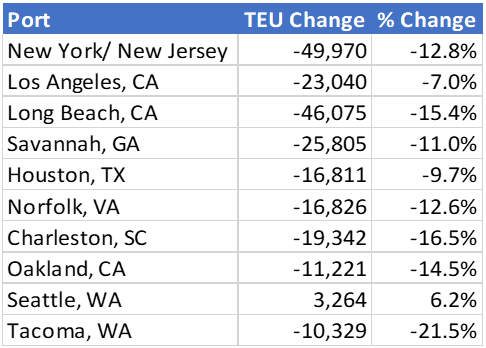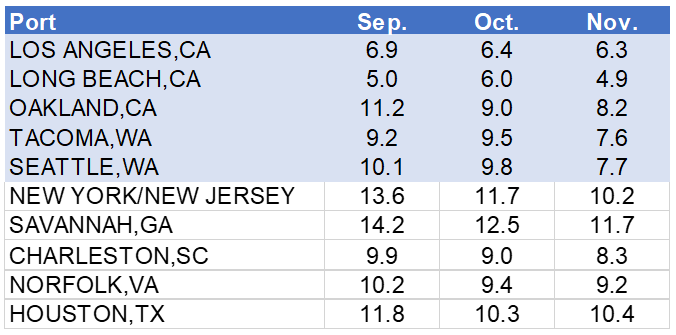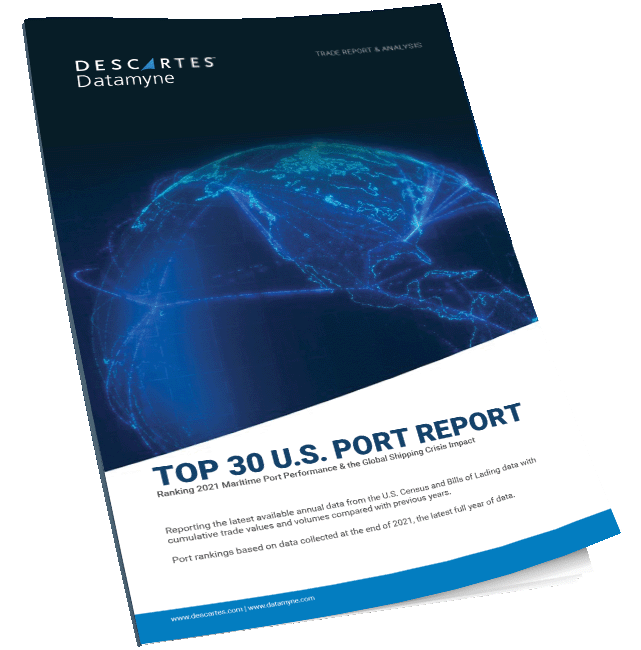The Global Shipping Crisis
November Decline in U.S. Container Import Volumes Approaches 2019 Levels
U.S. container import volumes in November declined close to volumes in November 2019. Port delays, meanwhile, continued to improve, especially for West Coast ports as their import volumes are down significantly versus 2021. Key economic indicators such as the growth of the economy, jobs, inflation, interest rates and fuel costs paint a conflicting picture of their impact on the future direction of U.S. container import volumes. Chinese imports again declined, but other countries such as Vietnam and Thailand experienced more significant drops. The December update of the logistics metrics Descartes is tracking shows more relief but continues to point to congested and challenging global supply chain performance going into 2023.
In this Article...
- toc
November U.S. container imports approached 2019 November volumes.
November 2022 U.S. container import volumes declined 12.0% from October to 1,954,179 TEUs (see Figure 1). Versus November 2021, TEU volume was down 19.4%, and only 2.8% higher than pre-pandemic November 2019. Note that November is a shorter month (30 days) and contains the U.S. Thanksgiving holiday, both of which can negatively impact container import volumes.
Figure 1: U.S. Container Import Volume Year-over-Year Comparison

Source: Descartes Datamyne™
Comparing fall imports in 2022 to the previous six years, November would have been expected to be lower than October (see Figure 2); however, November 2022 had the greatest October-to-November decline since 2016 at 12%, although November 2018 also saw a large decline (10.9%).
Figure 2: October to November U.S. Container Import Volume Comparison

Source: Descartes Datamyne™
All of the top 10 U.S. ports saw volume declines with the exception of the Port of Seattle (see Figure 3). The Ports of New York/New Jersey and Long Beach experienced the greatest decline.
Figure 3: October to November Comparison of Import Volumes at Top 10 U.S. Ports

Source: Descartes Datamyne™
The downward trend continued in November for U.S. container imports from China to 686,514 TEUs, a reduction of 11.1% versus October and down 31.5% from the 2022 high in August. China represented 35.1% of the total U.S. container imports, a decline of 6.4% from the high of 41.5% in February 2022. Of the top 10 countries importing into the U.S., Vietnam, Thailand and Germany on a percentage basis fared worse than China in November versus October (see Figure 4).
Figure 4: October to November Comparison of U.S. Import Volumes from Top 10 Countries of Origin

Source: Descartes Datamyne
West Coast ports continue to lose volume and market share.
In November, East and Gulf Coast ports maintained a smaller lead in volume over West Coast ports versus October 2022, and their overall share also remained the same. Comparing the top five West Coast ports to the top five East and Gulf Coast ports in November 2022 versus October 2022 shows that, of the total import container volume, the East and Gulf Coast ports declined slightly in November to 47.2%, down 0.7% versus October, and the West Coast ports stabilized at 36.9 in November, up 0.3% versus October. The top 10 ports lost some share in November 2022 to smaller ports, as the top 10 represented 84.1% of all volume compared with 84.3% in October 2022 and 86.6% year-on-year.
Comparing five-month periods (see Figure 5), the top West Coast ports (orange) continue to experience container throughput shifts to other ports, including the East and Gulf Coasts (blue). The Port of New York/New Jersey remained the top spot at 340,969 TEUs in October November 2022. The Port of Los Angeles came in second at 306,547 TEUs and Long Beach was third at 254,158 TEUs.
Figure 5: Container Import Volume Shifts at the Top 10 Ports

Source: Descartes Datamyne
November port delays continue to decline, especially for the West Coast ports.
Overall port delays in November 2022 were lower than October 2022 (See Figure 6). The major West Coast ports are all now well below 10 days and the Port of Long Beach is in the five-day range. Much of the progress can be attributed to the reduction in volume that these two West Coast ports are experiencing. Delays at all the major East and Gulf Coast ports improved but are still longer versus the major West Coast ports, with three of the ports (Savannah, Houston and New York/New Jersey) still experiencing higher double-digit delays.
Figure 6: Monthly Average Delays (in days) at Top 10 Ports

Source: Descartes Datamyne™
Note: Descartes’ definition of port delay is the difference as measured in days between the Estimated Arrival Date, which is initially declared on the bill of lading, and the date when Descartes receives the CBP-processed bill of lading.
Labor, COVID and macroeconomic issues persist.
The labor situation remains unchanged and presents continued risk to West Coast port operations. The International Longshore and Warehouse Union (ILWU) contract expired on July 1; however, business has proceeded as usual with the union working with management. Until now there has been no impact on container processing as has been the case in the past. California law AB5 still remains a significant issue with no resolution in sight and there is a risk that more AB5-related stoppages could occur in other California ports in the future causing greater disruption. The continuing labor uncertainty could be a significant reason why import volumes are not shifting back to major California ports despite their improving situation.
The Chinese government has just revised its COVID policies in an effort to minimize the disruptions to society and business. However, they’re still fairly restrictive and time will tell if China can get control of its COVID outbreaks without severely impacting global supply chains.
Key economic indicators provide a mixed view of the U.S. economy and, ultimately, demand for imports. The economy grew slightly (2.9%) in the third quarter versus the second quarter and employment increased by 263,000 jobs; unemployment remained close to record levels at 3.7%. Inflation declined slightly to 7.7% in November but remains high. According to the U.S. Energy Information Association, gasoline costs, a significant contributor to high inflation rates, declined slightly to $3.39/gallon and is back to 2021 prices for the same period. Diesel costs also saw a small reduction to $4.97/gallon. Both are likely to remain elevated for the foreseeable future given the disruption of global energy markets as a result of the war in Ukraine and subsequent sanctions on Russia.
To access other articles that track port congestion monthly, visit the
Global Shipping Resource Center
White Papers
Survey Uncovers Supply Chain Strategies of Top Performing Companies
Surviving Peak Season and Beyond: The Essential Guide to Supply Chain Resiliency

Executive Vice President of Industry and Services
Descartes Systems Group
The Must-Read Guide on U.S. Maritime Ports

See the impact port congestion has had on U.S. imports, and gain insights into how to mitigate risks in your supply chain.
Stay Informed. Download the Report.
Managing supply chain risk: what to watch as 2022 closes.
U.S. import volume declined again in November and now the question is will 2023 look more like 2019, but with more supply chain turbulence. In addition, several significant one-time events could exacerbate the ability to move goods globally. Here’s what Descartes will be watching:
- Monthly TEU volumes between 2.4M and 2.6M. This level will continue to stress ports and inland logistics until infrastructure can be enhanced. November U.S. container import volume is approaching 2019 levels.
- Port wait times. If they decrease, it’s an indication of improved port processing capabilities or that the demand for goods and logistics services is declining. Port wait times were down again slightly in November but were still much higher at East and Gulf Coast ports.
- Continuing impact of the pandemic. The spread of COVID subvariants continues to add uncertainty to the trajectory of the pandemic and impact supply chains in unpredictable ways as different countries are affected at different times and for different durations. China is still maintaining its strict rules, does not appear to have a remedy to the situation and there are lockdowns that are impacting some supply chains.
- Key economic indicators such as the inflation rate, monthly BLS Jobs Report, FRED Inventory to Sales Ratio and FRED Personal Consumption Expenditure: Durable Goods. A fundamental change in consumer buying behavior from services to goods occurred early in the pandemic and was the force behind the dramatic increase in U.S. container import volumes over the last two years. The November numbers for the economy and jobs are still contrary to the expected impact of high inflation figures and fuel prices.
- ILWU contract negotiations. The ILWU contract has expired, but to date there hasn’t been an impact on West Coast port operations; however, California AB5 has the potential to cause more disruptions to California port operations. There has been no indication of progress or a date for an agreement.
- Inflation and the Russia/Ukraine conflict. Inflation may be the only way to slow down the strong U.S. economy and ultimately help to alleviate the global logistics capacity-related problems that exist. Inflation remained high in November and diesel costs increased. Both diesel and gas prices remain high due to the effect of the Russia/Ukraine conflict.
Consider recommendations to help mitigate the pressure of ongoing global shipping disruptions.
The decline in November 2022 U.S. container import volumes, along with the September and October numbers, are starting to point to imports operating closer to pre-pandemic levels going into 2023. The U.S. economy remains relatively strong despite numerous pressures to slow it down. Overall, ports are continuing to process large volumes of containers. The major West Coast ports are operating significantly below all-time import highs and are seeing the greatest reduction in port delays. Despite volume reductions in November, major East and Gulf Coast ports are operating above traditional volumes and still experiencing double-digit delays. Unresolved labor-related issues are keeping importers from moving volume back to the West Coast. This data reaffirms that the pressure on supply chains and logistics operations has begun to lift, but there are still issues that can cause further disruptions. Descartes will continue to highlight key Descartes Datamyne, U.S. government and industry data in the coming months to provide insight into the global shipping crisis. We are staying the course with our current perspectives and recommendations:
Short-term:
- Monitor the impact of California law AB5 on owner-operators serving California ports for potential disruption or degradation of port container processing performance.
- Monitor ILWU contract negotiations for progress.
- Track the spread of COVID variants to determine when they will hit critical parts of the supply chain, especially in China and other countries with severe containment policies.
- Track ocean shipments to monitor port delays, in particular for the East and Gulf Coast ports.
- Evaluate the impact of inflation and the Russia/Ukraine conflict on logistics costs and capacity constraints. Ensure that key trading partners are not on sanctions lists.
- Focus on keeping the supply chain resources you have, especially drivers. The old adage “a bird in the hand is worth more than two in the bush” definitely applies here. Building trips to reduce stress and improve quality of life to retain drivers is now as or more important than wage increases.
Near-term:
- Reevaluate the flow of goods as major East and Gulf Coast ports are still experiencing greater delays and the Ports of Los Angeles and Long Beach are seeing significant reductions in wait times.
- Continue to look for less congested transportation lanes, including smaller ports, to improve supply chain velocity and reliability. Total transit time is important, but so is supply chain predictability. Evaluate alternative transportation lanes into the U.S., including entry through northern and southern borders and inland ports.
Long-term:
- Evaluate supplier and factory location density to mitigate reliance on over-taxed trade lanes and regions of the globe that have the potential for conflict. Density creates economy of scale but also risk, and the pandemic and subsequent logistics capacity crisis highlights the downside. Conflicts do not happen “overnight” so now is the time to address this potentially business disrupting issue.
Note: This report uses the initial compiled release of U.S. Customs and Border Protection (CBP) data and is subject to revision at a later date by CBP. The revised data can be seen in Descartes Datamyne.
How Descartes Can Help
Descartes Datamyne delivers business intelligence with comprehensive, accurate, up-to-date, import and export information.
Our multinational trade data assets can be used to trace global supply chains and our bill-of-lading trade data – with cross-references to company profiles and customs information – can help businesses identify and qualify new sources. Ask us for a free, no obligation demonstration of our data on a product or trade commodity of your choosing – and keep the custom research we create with our compliments.
